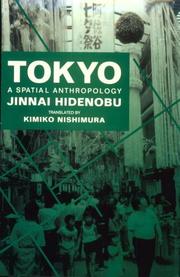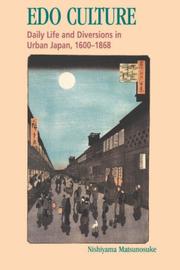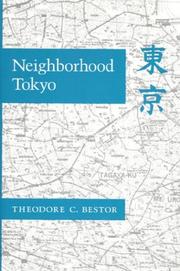| Listing 1 - 9 of 9 |
Sort by
|
Book
ISBN: 2862600709 9782862600703 Year: 1984 Volume: 8 Publisher: Paris: Autrement,
Abstract | Keywords | Export | Availability | Bookmark
 Loading...
Loading...Choose an application
- Reference Manager
- EndNote
- RefWorks (Direct export to RefWorks)

ISBN: 0520071352 Year: 1995 Publisher: Berkeley : University of California Press,
Abstract | Keywords | Export | Availability | Bookmark
 Loading...
Loading...Choose an application
- Reference Manager
- EndNote
- RefWorks (Direct export to RefWorks)
City planning --- Open spaces --- Urban anthropology. --- Urbanisme --- Espaces verts --- Anthropologie urbaine --- History. --- Planning --- Histoire --- Planification --- Tokyo (Japan) --- Tokyo (Japon) --- Social conditions. --- Conditions sociales --- J4190.12 --- J3411.10 --- J4192 --- Japan: Sociology and anthropology -- local communities and culture -- Kantō -- Tōkyō 23 ward area (Edo) --- Japan: Geography and local history -- Kantō -- Tōkyō 23 wards area (Edo) --- Japan: Sociology and anthropology -- communities -- urban groups, the city --- Urban anthropology --- Anthropology, Urban --- Ethnology --- Land use --- History --- Planning&delete& --- J6580 --- Japan: Art and antiquities -- urban planning --- Built environment

ISBN: 0824817362 0824818504 9780824818500 9780824817367 0585309523 0824862295 Year: 1997 Publisher: Honolulu, HI: University of Hawai'i Press,
Abstract | Keywords | Export | Availability | Bookmark
 Loading...
Loading...Choose an application
- Reference Manager
- EndNote
- RefWorks (Direct export to RefWorks)
Japan --- Civilization --- 1600-1868 --- J4140.60 --- J4000.60 --- J3360 --- J4190.12 --- J4192 --- Japan: Sociology and anthropology -- cultural history -- Kinsei, Edo, Tokugawa period, early modern (1600-1867) --- Japan: Social history, history of civilization -- Kinsei, Edo, Tokugawa period, early modern (1600-1867) --- Japan: History -- Kinsei, Edo, Tokugawa period, early modern (1600-1867) --- Japan: Sociology and anthropology -- local communities and culture -- Kantō -- Tōkyō 23 ward area (Edo) --- Japan: Sociology and anthropology -- communities -- urban groups, the city --- J4150.60 --- Japan - Civilization - 1600-1868

ISBN: 0804714398 9780804714396 0804717974 9780804717977 0934714398 9780934714396 Year: 1989 Publisher: Stanford, Calif.: Stanford university press,
Abstract | Keywords | Export | Availability | Bookmark
 Loading...
Loading...Choose an application
- Reference Manager
- EndNote
- RefWorks (Direct export to RefWorks)
In the vastness of Tokyo these are tiny social units, and by the standards that most Americans would apply, they are perhaps far too small, geographically and demographically, to be considered "neighborhoods." Still, to residents of Tokyo and particularly to the residents of any given subsection of the city, they are socially significant and geographically distinguishable divisions of the urban landscape. In neighborhoods such as these, overlapping and intertwining associations and institutions provide an elaborate and enduring framework for local social life, within which residents are linked to one another not only through their participation in local organizations, but also through webs of informal social, economic, and political ties. This book is an ethnographic analysis of the social fabric and internal dynamics of one such neighborhood: Miyamoto-cho, a pseudonym for a residential and commercial district in Tokyo where the author carried out fieldwork from June 1979 to May 1981, and during several summers since. It is a study of the social construction and maintenance of a neighborhood in a society where such communities are said to be outmoded, even antithetical to the major trends of modernization and social change that have transformed Japan in the last hundred years. It is a study not of tradition as an aspect of historical continuity, but of traditionalism: the manipulation, invention, and recombination of cultural patterns, symbols, and motifs so as to legitimate contemporary social realities by imbuing them with a patina of venerable historicity. It is a study of often subtle and muted struggles between insiders and outsiders over those most ephemeral of the community's resources, its identity and sense of autonomy, enacted in the seemingly insubstantial idioms of cultural tradition.
Neighborhoods --- Tokyo (Japan) --- Social conditions --- Alltag. --- Nachbarschaft. --- Neighborhoods. --- Quartiers (Urbanisme) --- Seikatsukankyō. --- Social conditions. --- Sociale situatie. --- Stadswijken. --- Stadtviertel. --- Tōkyōto --- Vie urbaine --- Wohnen. --- quartier (urbanisme) --- Fūzokushūkan. --- Shakai. --- Japan --- Tokio --- Tokio. --- Tōkyō (Japon) --- Condiciones sociales --- Conditions sociales. --- Tokyo (Japon) --- Conditions sociales --- J4190.12 --- J4192 --- J4000.90 --- J3411.10 --- Neighborhood --- -Neighborhood --- Neighbourhoods --- Communities --- Japan: Sociology and anthropology -- local communities and culture -- Kantō -- Tōkyō 23 ward area (Edo) --- Japan: Sociology and anthropology -- communities -- urban groups, the city --- Japan: Social history, history of civilization -- postwar Shōwa (1945- ), Heisei period (1989- ), contemporary --- Japan: Geography and local history -- Kantō -- Tōkyō 23 wards area (Edo) --- -Tokyo (Japan : Prefecture) --- Tokyo Metropolitan Government (Japan) --- Tonggyŏng (Japan) --- Tokio (Japan) --- Tʻokʻyoo (Japan) --- Tung-ching tu (Japan) --- Tung-ching tu tʻing (Japan) --- Tōkyō-shi (Japan) --- Tung-ching (Japan) --- Dongjing (Japan) --- 東京 (Japan) --- Tokyo Metropolis (Japan) --- 東京都 (Japan) --- Tōkyō-to (Japan) --- طوكيو (Japan) --- Ṭūkiyū (Japan) --- Горад Токіа (Japan) --- Horad Tokia (Japan) --- Токіа (Japan) --- Tokia (Japan) --- Токио (Japan) --- Edo (Japan) --- Shinagawa-ken (Japan) --- Tokyo (Japan : Fu) --- -J4190.12 --- -東京 (Japan) --- Tokyo (Japan : Prefecture) --- 동경 (Japan) --- Dongjing du (Japan) --- Dongjing du ting (Japan) --- 东京 (Japan) --- Toukio (Japan) --- -Neighborhoods --- -Japan: Sociology and anthropology -- local communities and culture -- Kantō -- Tōkyō 23 ward area (Edo) --- -Social conditions --- -Alltag. --- Neighborhoods - Japan - Tokyo --- Tokyo (Japan) - Social conditions --- -Neighborhoods - Japan - Tokyo --- -Tokyo (Japan)
Book

ISBN: 9780231182775 9780231182768 9780231544351 0231544359 Year: 2017 Publisher: New York Columbia University Press
Abstract | Keywords | Export | Availability | Bookmark
 Loading...
Loading...Choose an application
- Reference Manager
- EndNote
- RefWorks (Direct export to RefWorks)
By 1816, Japan had recovered from the famines of the 1780s and moved beyond the political reforms of the 1790s. Despite persistent economic and social stresses, the country seemed headed for a new period of growth. The idea that the shogunate would not last forever was far from anyone's mind.Yet, in that year, an anonymous samurai produced a scathing critique of Edo society. Writing as Buyo Inshi, "a retired gentleman of Edo," he expressed in An Account of What I Have Seen and Heard a profound despair with the state of the realm. Seeing decay wherever he turned, Buyo feared the world would soon descend into war.In his anecdotes, Buyo shows a sometimes surprising familiarity with the shadier aspects of Edo life. He speaks of the corruption of samurai officials; the suffering of the poor in villages and cities; the operation of brothels; the dealings of blind moneylenders; the selling and buying of temple abbotships; and the dubious strategies seen in law courts. Perhaps it was the frankness of his account that made him prefer to stay anonymous.A team of Edo specialists undertook the original translation of Buyo's work. This abridged edition streamlines this translation for classroom use, preserving the scope and emphasis of Buyo's argument while eliminating repetitions and diversions. It also retains the introductory essay that situates the work within Edo society and history.
Social classes --- Class distinction --- Classes, Social --- Rank --- Caste --- Estates (Social orders) --- Social status --- Class consciousness --- Classism --- Social stratification --- History --- Japan --- Social life and customs --- Social conditions --- J3411.10 --- J4000.60 --- J4190.12 --- Japan: Geography and local history -- Kantō -- Tōkyō 23 wards area (Edo) --- Japan: Social history, history of civilization -- Kinsei, Edo, Tokugawa period, early modern (1600-1867) --- Japan: Sociology and anthropology -- local communities and culture -- Kantō -- Tōkyō 23 ward area (Edo) --- al-Yābān --- Giappone --- Government of Japan --- Iapōnia --- I︠A︡ponii︠a︡ --- Japam --- Japani --- Japão --- Japon --- Japonia --- Japonsko --- Japonya --- Jih-pen --- Mư̄ang Yīpun --- Nihon --- Nihon-koku --- Nihonkoku --- Nippon --- Nippon-koku --- Nipponkoku --- Prathēt Yīpun --- Riben --- State of Japan --- Yābān --- Yapan --- Yīpun --- Zhāpān --- Япония --- اليابان --- يابان --- 日本 --- 日本国 --- Economic conditions --- Moral conditions --- Jepun --- Yapon --- Yapon Ulus --- I︠A︡pon --- Япон --- I︠A︡pon Uls --- Япон Улс
Book
ISBN: 9784866581323 4866581328 Year: 2020 Publisher: Tokyo : Japan Publishing Industry Foundation for Culture,
Abstract | Keywords | Export | Availability | Bookmark
 Loading...
Loading...Choose an application
- Reference Manager
- EndNote
- RefWorks (Direct export to RefWorks)
Bridges --- Scrolls, Japanese --- Japan --- Nihonbashi (Tokyo, Japan) --- Social life and customs --- J6290 --- J4192 --- J4190.12 --- J4150.60 --- J3411.10 --- Bridges, Highway --- Express highways --- Highway bridges --- Transportation --- Viaducts --- Japan: Art and antiquities -- painting and drawing -- type and form -- illustrative works --- Japan: Sociology and anthropology -- communities -- urban groups, the city --- Japan: Sociology and anthropology -- local communities and culture -- Kantō -- Tōkyō 23 ward area (Edo) --- Japan: Sociology and anthropology -- cultural history -- Kinsei, Edo, Tokugawa period, early modern (1600-1867) --- Japan: Geography and local history -- Kantō -- Tōkyō 23 wards area (Edo) --- Nihon Bridge (Tokyo, Japan) --- al-Yābān --- Giappone --- Government of Japan --- Iapōnia --- I︠A︡ponii︠a︡ --- Japam --- Japani --- Japão --- Japon --- Japonia --- Japonsko --- Japonya --- Jih-pen --- Mư̄ang Yīpun --- Nihon --- Nihon-koku --- Nihonkoku --- Nippon --- Nippon-koku --- Nipponkoku --- Prathēt Yīpun --- Riben --- State of Japan --- Yābān --- Yapan --- Yīpun --- Zhāpān --- Япония --- اليابان --- يابان --- 日本 --- 日本国 --- Jepun --- Yapon --- Yapon Ulus --- I︠A︡pon --- Япон --- I︠A︡pon Uls --- Япон Улс
Book
ISBN: 9780230622364 Year: 2010 Publisher: New York Palgrave Macmillan
Abstract | Keywords | Export | Availability | Bookmark
 Loading...
Loading...Choose an application
- Reference Manager
- EndNote
- RefWorks (Direct export to RefWorks)
Anthropological linguistics --- Gay men --- Gender identity --- Lesbians --- Identity. --- Language. --- Tokyo (Japan) --- Social life and customs. --- J4172 --- J4178 --- J4176 --- J4127 --- J4190.12 --- J4192 --- -Gay men --- -Lesbians --- -Anthropological linguistics --- -Gender identity --- -Sex identity (Gender identity) --- Sexual identity (Gender identity) --- Identity (Psychology) --- Sex (Psychology) --- Queer theory --- Anthropo-linguistics --- Ethnolinguistics --- Language and ethnicity --- Linguistic anthropology --- Linguistics and anthropology --- Anthropology --- Language and culture --- Linguistics --- Female gays --- Female homosexuals --- Gay females --- Gay women --- Gayelles --- Gays, Female --- Homosexuals, Female --- Lesbian women --- Sapphists --- Women, Gay --- Women homosexuals --- Gays --- Women --- Gays, Male --- Homosexuals, Male --- Male gays --- Urnings --- Men --- Japan: Sociology and anthropology -- family and interpersonal relations -- sex relations (identity, preference, community, customs and culture) --- Japan: Sociology and anthropology -- gender, men --- Japan: Sociology and anthropology -- gender roles, women, feminism --- Japan: Sociology and anthropology -- social identity and self --- Japan: Sociology and anthropology -- local communities and culture -- Kantō -- Tōkyō 23 ward area (Edo) --- Japan: Sociology and anthropology -- communities -- urban groups, the city --- -Social life and customs --- -Japan: Sociology and anthropology -- family and interpersonal relations -- sex relations (identity, preference, community, customs and culture) --- Sex identity (Gender identity) --- Identity --- Language --- Male homosexuals --- Gender dysphoria
Book
ISBN: 9780822985778 0822985772 Year: 1995 Publisher: Pittsburgh University of Pittsburgh Press
Abstract | Keywords | Export | Availability | Bookmark
 Loading...
Loading...Choose an application
- Reference Manager
- EndNote
- RefWorks (Direct export to RefWorks)
In this pre-World War II analysis of working-class areas of Tokyo, primarily its Honjo ward, Hastings shows that bureaucrats, particularly in the Home Ministry, were concerned with the needs of their citizens and took significant steps to protect the city's working families and the poor. She also demonstrates that the public participated broadly in politics, through organizations such as reservist groups, national youth leagues, neighborhood organizations, as well as growing suffrage and workplace organizations.
Political participation --- Working class --- Neighborhoods --- J3411.10 --- J4192 --- J4190.12 --- J4672.12 --- J4000.80 --- Neighborhood --- Neighbourhoods --- Communities --- Commons (Social order) --- Labor and laboring classes --- Laboring class --- Labouring class --- Working classes --- Social classes --- Labor --- Citizen participation --- Community action --- Community involvement --- Community participation --- Involvement, Community --- Mass political behavior --- Participation, Citizen --- Participation, Community --- Participation, Political --- Political activity --- Political behavior --- Political rights --- Social participation --- Political activists --- Politics, Practical --- History --- Japan: Geography and local history -- Kantō -- Tōkyō 23 wards area (Edo) --- Japan: Sociology and anthropology -- communities -- urban groups, the city --- Japan: Sociology and anthropology -- local communities and culture -- Kantō -- Tōkyō 23 ward area (Edo) --- Japan: Politics and law -- local politics and government -- Kantō -- Tōkyō 23 ward area (Edo) --- Japan: Social history, history of civilization -- Gendai (1926- ), Shōwa period, 20th century --- Employment --- Tokyo (Japan) --- Tokyo (Japan : Prefecture) --- Tokyo Metropolitan Government (Japan) --- Tonggyŏng (Japan) --- Tokio (Japan) --- Tʻokʻyoo (Japan) --- Tung-ching tu (Japan) --- Tung-ching tu tʻing (Japan) --- Tōkyō-shi (Japan) --- Tung-ching (Japan) --- Dongjing (Japan) --- 東京 (Japan) --- Tokyo Metropolis (Japan) --- 東京都 (Japan) --- Tōkyō-to (Japan) --- طوكيو (Japan) --- Ṭūkiyū (Japan) --- Горад Токіа (Japan) --- Horad Tokia (Japan) --- Токіа (Japan) --- Tokia (Japan) --- Токио (Japan) --- Edo (Japan) --- Shinagawa-ken (Japan) --- Tokyo (Japan : Fu) --- Politics and government. --- Social policy. --- 동경 (Japan) --- Dongjing du (Japan) --- Dongjing du ting (Japan) --- 东京 (Japan) --- Toukio (Japan) --- Political participation.
Book
ISBN: 0804778574 9780804778572 9780804771443 0804771448 9780804771450 0804771456 Year: 2011 Publisher: Stanford, CA : Stanford University Press,
Abstract | Keywords | Export | Availability | Bookmark
 Loading...
Loading...Choose an application
- Reference Manager
- EndNote
- RefWorks (Direct export to RefWorks)
This work discusses literary depictions of mass transit in 20th century Tokyo in the decades preceding WWII. It cuts across literary and historical/sociological analysis, and contributes to the growing body of work examining Japanese urbanism, gender, and modernism.
Japanese literature --- Commuting in literature. --- Railroad travel in literature. --- Commuting --- Railroad travel --- Local transit --- City transit --- Mass transit --- Municipal transit --- Public transit --- Rapid transit --- Transit systems --- Urban transit --- Transportation --- Ridesharing --- Rail travel --- Railroads --- Routes of travel --- Train travel --- Travel --- Voyages and travels --- Telecommuting --- History and criticism. --- Social aspects --- History --- Tokyo (Japan) --- Tokyo (Japan : Prefecture) --- Tokyo Metropolitan Government (Japan) --- Tonggyŏng (Japan) --- Tokio (Japan) --- Tʻokʻyoo (Japan) --- Tung-ching tu (Japan) --- Tung-ching tu tʻing (Japan) --- Tōkyō-shi (Japan) --- Tung-ching (Japan) --- Dongjing (Japan) --- 東京 (Japan) --- Tokyo Metropolis (Japan) --- 東京都 (Japan) --- Tōkyō-to (Japan) --- طوكيو (Japan) --- Ṭūkiyū (Japan) --- Горад Токіа (Japan) --- Horad Tokia (Japan) --- Токіа (Japan) --- Tokia (Japan) --- Токио (Japan) --- Edo (Japan) --- Shinagawa-ken (Japan) --- Tokyo (Japan : Fu) --- Social life and customs --- In literature. --- Commuting in literature --- Railroad travel in literature --- J4150.80 --- J4190.12 --- J4192 --- J4470 --- J5500.80 --- J5509 --- J5930 --- History and criticism --- Japan: Sociology and anthropology -- cultural history -- Gendai (1926- ), Shōwa period, 20th century --- Japan: Sociology and anthropology -- local communities and culture -- Kantō -- Tōkyō 23 ward area (Edo) --- Japan: Sociology and anthropology -- communities -- urban groups, the city --- Japan: Economy and industry -- transportation and infrastructure --- Japan: Literature -- history and criticism -- Gendai (1926- ), Shōwa period, 20th century --- Japan: Literature -- theory, methodology and philosophy --- Japan: Literature -- modern fiction and prose (1868- ) --- 동경 (Japan) --- Dongjing du (Japan) --- Dongjing du ting (Japan) --- 东京 (Japan) --- Toukio (Japan)
| Listing 1 - 9 of 9 |
Sort by
|

 Search
Search Feedback
Feedback About UniCat
About UniCat  Help
Help News
News